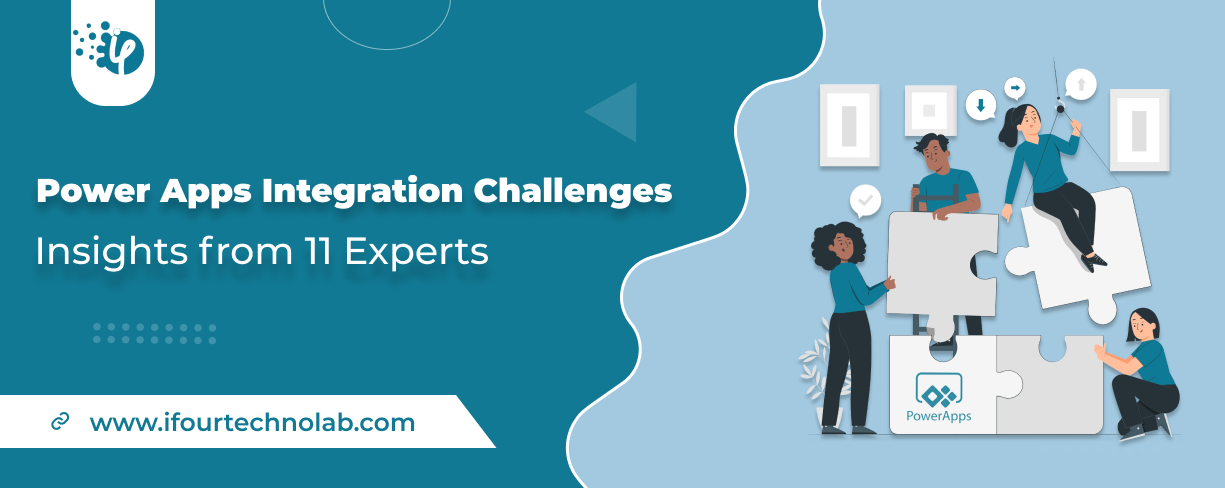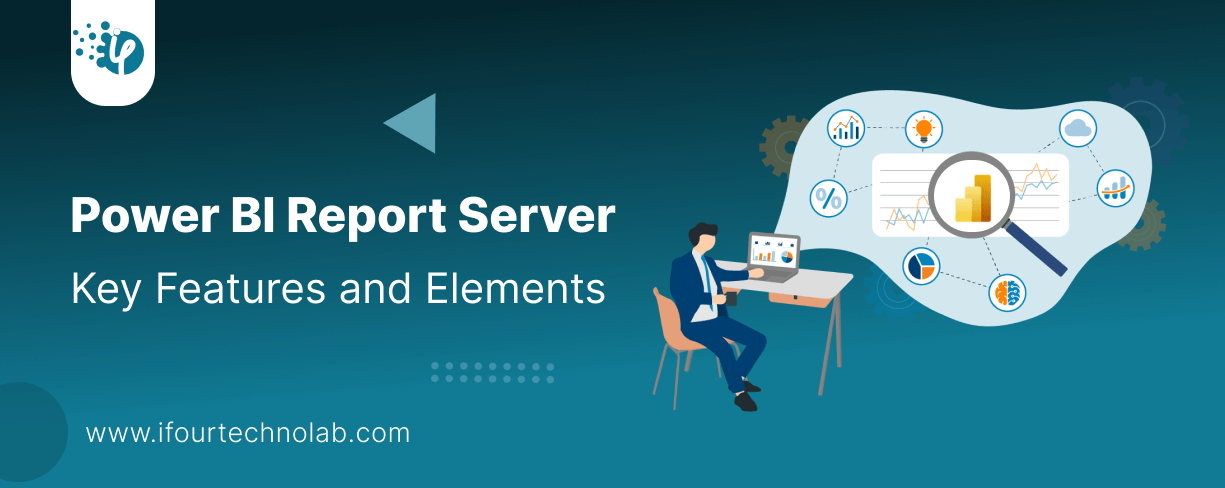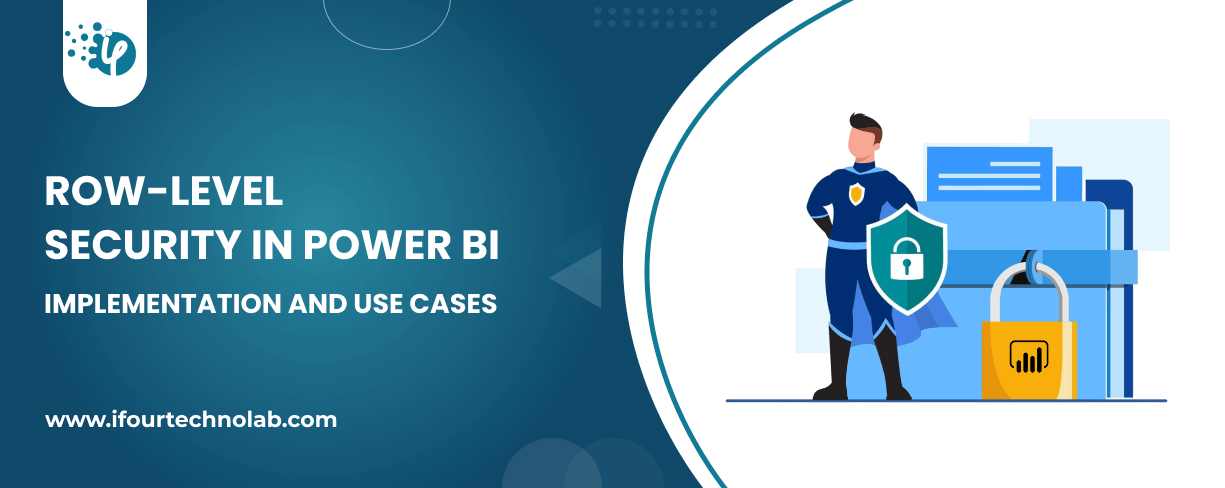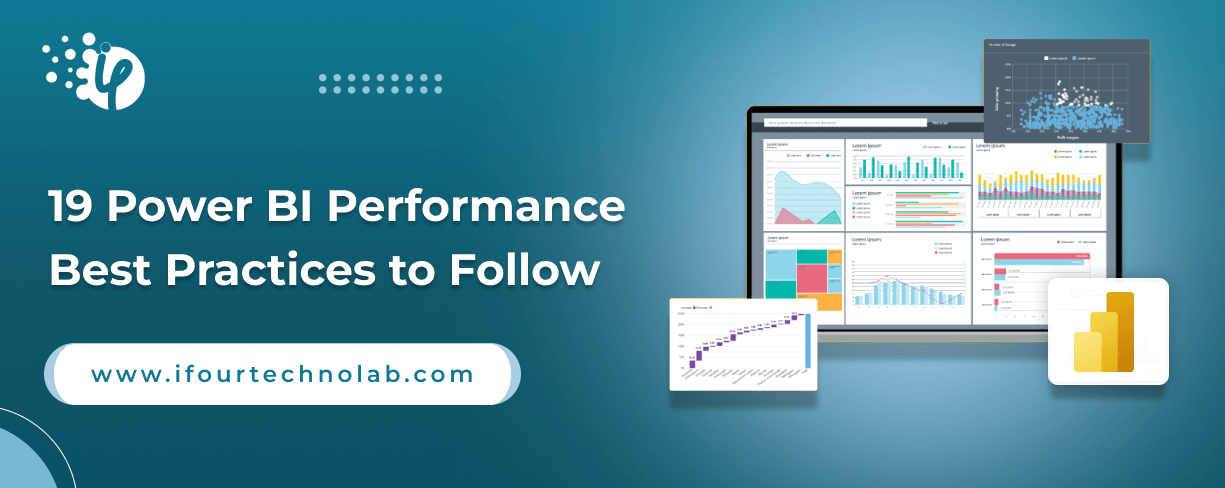Power BI Report Server: Key Features and Elements
Every CTO knows the struggle of managing complex reports. The inefficiency of scattered data, the constant juggling between reporting tools, the challenge of ensuring accurate KPIs...
Kapil Panchal - November 28, 2024
Listening is fun too.
Straighten your back and cherish with coffee - PLAY !

Microsoft Power Apps has caught great hype in recent days. Why? because it helps you build apps 50% faster, saves 250+ hours annually, and improves productivity by 12%
Several businesses including Fortune 500 companies eagerly adopted Microsoft Power Apps. But what challenges they faced during integration is still a big question.
To deal with this, we interviewed various experts and gathered responses on common challenges faced during Power Apps integration and solutions to overcome them.
Dealing with Power Apps challenges early on would help you make the Power Apps integration smoother and more impactful. Let’s look at what experts have to say about it.
Chris Dukich, Founder of a SaaS company - Display Now, shares the Power Apps Integration Challenges that he faced. He knows the ins and outs of software integrations, including Microsoft Power Apps, and offers strategies that can help enterprises successfully integrate Power Apps.
Chris highlights the difficulties when integrating Power Apps with third-party systems or legacy platforms.

While Power Apps offers immense potential, overcoming integration challenges requires careful planning, custom solutions, and a focus on security and training. Strategies on compatibility, security, and adoption have been critical in our success with Power Apps integration and could be invaluable to other businesses facing similar roadblocks.
Chris highlights the difficulties when integrating Power Apps with third-party systems or legacy platforms.
“One of the greatest challenges is ensuring smooth communication, especially when building custom APIs and connectors for non-Microsoft platforms,” he explains. These custom solutions can extend deadlines and strain budgets.
To overcome data compatibility issues, Chris suggests that businesses either create their own custom connectors or leverage Microsoft’s existing ones. This approach helps to streamline the integration process and make it more efficient.
Security is always a priority, especially when dealing with sensitive data. For Power Apps integration in environments that handle critical information, ensuring that the apps meet enterprise-level security standards is challenging. “Power Apps must be handled with the same level of care as other enterprise applications, particularly when dealing with personal or financial data,” Chris stresses.
Security should be considered early on in the integration process. Chris recommends exploring Microsoft’s built-in compliance features, such as Microsoft Defender and Azure AD, to safeguard sensitive data and systems from the outset.
Another significant hurdle is user acceptability. Without proper training and an interactive interface, user engagement can drop, undermining the value of the integration. “Businesses must ensure their teams are comfortable with the new system,” Chris says, pointing out that training is essential for maximizing the returns on integration efforts.
Ensuring user adoption requires training that focuses on increasing comfort and productivity. “Investing in interactive training not only boosts adoption but also enhances overall productivity,” Chris notes, emphasizing that training is key to unlocking Power Apps' full potential.
Simplify your data journey with our Power BI consulting services today!
Scott Waters Owner of payment processing business
at Process Payments Now

As the owner of a payment processing business, I’ve faced some unique challenges while integrating Power Apps. One lesser-known issue was dealing with data silos. Our existing systems stored customer data in various locations, making it difficult to create a seamless workflow in Power Apps. To overcome this, we invested time in mapping our data setting and implementing a centralized database, which greatly improved efficiency.
Security concerns also loomed large. Integrating with third-party systems increased our vulnerability.
Scott tackled this by adopting a zero-trust security model. He says – “we adopted a zero-trust security model, ensuring that every user and device was verified before access. This added layer of security protected sensitive payment information.”
Another challenge was the need for extensive customization.
Scott shares “While Power Apps offers flexibility, creating specific features tailored to our needs required a deeper understanding of the platform. We utilized online forums and user groups to gather insights and learn from others’ experiences, which saved us time and frustration.”
Practical Take-Aways by Scott:
My advice is to -
Taking these steps can help streamline your integration and enhance user satisfaction.
Soumya Mahapatra, CEO of Essenvia says:

“Perhaps the biggest issue we ran into when integrating Power Apps was making sure we maintained good cybersecurity and privacy practices. We're in the medical device field, meaning that we sometimes have access to confidential information including patented designs and patient records, and ensuring that we restricted access to these files while still making full use of Power Apps was difficult. The two strategies we've had the most success with have been regular audits of file access, and creating separate logins for protected information.”
Achieve seamless integration through expert Power Platform consulting
Power Apps integration can be transformative but also comes with its own set of problems. Daniel Meursing, CEO and Founder of Premier Staff, shares his hands-on experience in tackling these challenges while managing high-profile luxury events.

Daniel Meursing says “One major challenge faced with Power Apps is customization for Unique Scenarios. handle the diverse demands of luxury events – let’s say celebrity parties. Such events required unique functionalities. To address this, his team adopted a modular approach, creating app components that could be swiftly reconfigured. This innovation allowed Premier Staff to adapt to client needs effectively.”
Integrating Power Apps with existing systems was another hurdle. "Seamless data flow was critical for our operations," Meursing explains. To solve this, his team developed a robust API layer, ensuring smooth interactions between custom AI-powered onboarding systems and client management tools. This enhancement significantly improved operational efficiency, particularly for managing multi-month activations for clients like Lionel Messi.
Ensuring adoption among a diverse workforce was crucial. Meursing shares, "We rolled out a comprehensive training program with role-specific tutorials, inspired by our Captain Development program." This tailored approach resulted in high adoption rates and enhanced staff performance across events such as Netflix productions and YSL fashion shows.
As Premier Staff expanded to larger events, scalability became a priority. Meursing explains how they optimized Power Apps for performance by implementing efficient data handling strategies. "This ensured we could manage everything from intimate gatherings to massive festivals seamlessly," he says.
So that’s how his experience highlights the common issues and resolutions for Power Apps.
Read More: Power Apps Solving 13 Legal Challenges
By utilizing MS Power Apps, they have not only improved operational efficiency but also set a new benchmark in digital event management.
He concludes, "Our mastery of Power Apps integration allows us to deliver unparalleled service quality in the dynamic world of luxury events."
Integrating Power Apps can help you with great opportunities, but it often comes with hurdles. Louis Balla, a partner at Nuage specializing in NetSuite and IFS ERP solutions, shares the challenges his team faced and the strategies they used to overcome them.

Establishing secure connections was another roadblock, often requiring intricate firewall reconfigurations. We tackled this by implementing robust data security classifications, role-based access controls, and auditing procedures - enabling self-service capabilities without compromising security.
“Compatibility was a major issue when integrating Power Apps with legacy on-premise systems,” Louis explains. API limitations and mismatched data structures meant custom coding was essential to ensure smooth data mapping and system communication.
“Initially, employees hesitated to adopt Power Apps,” Louis notes. To address this, his team demonstrated clear productivity benefits and created tailored training programs, turning resistance into enthusiasm. This change management approach proved crucial in gaining team buy-in.
Large data volumes and intricate business logic posed technical challenges. “Not all processes could be effectively modeled in Power Apps,” he adds. By starting with simple use cases and gradually expanding functionalities, the team built momentum and success.
Key Advice
Better to have thoughtful planning, robust security measures, and change management during Power Apps integration. Whether it's dealing with legacy systems or fostering user acceptance, purpose with strategic planning can turn challenges into opportunities.
His advice? “Start small, focus on user training, and ensure a secure foundation to unlock the full potential of Power Apps.”
Boost productivity with expert Power Automate consulting services
Ryan T. Murphy, a CRM and marketing automation expert at UpfrontOperations, shares his real-world challenges and solutions in integrating Power Apps into complex business workflows.

We faced API restrictions and compatibility issues when integrating Power Apps with on-premise systems. Custom mappings and firewall adjustments were required to ensure seamless data flow. Our dedicated team employed custom coding and an iterative development strategy to tackle these hurdles incrementally for complex processes and large data volumes that Power Apps couldn't handle natively.
"Power Apps initially raised data security concerns due to its open access," Ryan explains. His team implemented strict data classifications and role-based access controls before rolling out the tool. By starting with basic use cases, they ensured a controlled environment that gradually expanded as user confidence grew.
“Employees were hesitant at first, worried that Power Apps would complicate their work,” Ryan recalls. To counter this, his team demonstrated how the tool could automate repetitive tasks and save time. The impact was clear: adoption rates surged by over 40% within three months once users experienced its benefits firsthand.
Ryan’s journey highlights the need for a phased approach: secure your data, simplify processes, and focus on demonstrating quick wins to drive adoption. His advice resonates strongly: “Start small, engage your team early, and iterate to scale successfully.”
We interviewed Mr. Vinod Satapara, Director of iFour Technolab on the challenges of using Power Apps. He pointed out some of the major Power Apps limitations and the possible solutions (from a technical perspective).

He says, “We have been rigorously using Power Apps and delivered quick apps for our clients from healthcare, fintech, and legal. Here are the limitations/challenges we observed.
Solution: You can use delegation techniques to handle more data effectively.
We used Canvas apps recently and it allows only one developer to work at a time. This could be a major challenge when it comes to efficiency.
Solution: Better you plan your development process keenly to avoid delays.
Solution: Opt for alternatives like OneDrive or SharePoint to store attachments seamlessly.
Solution: Explore Power Fx or other tools for scripting needs.
Build cross-platform apps with a top-class .NET MAUI development company
Ryan T. Murphy, a seasoned CRM expert with 8+ years of experience optimizing systems across industries, shares his approach to addressing Power Apps integration challenges.
"The biggest challenge was aligning our intricate data models and business logic with Power Apps' simpler interface," Ryan shares. His solution? Start small. By initially tackling basic use cases, his team demonstrated tangible value and built trust, paving the way for more complex integrations later.
Legacy systems posed compatibility hurdles, requiring extensive custom coding to map data and establish secure connections. Despite API limitations and schema mismatches, the outcome was transformative: a unified data source that slashed manual reporting efforts by over 60%.
Given Power Apps' open data access, Ryan emphasized the importance of role-based controls and audits to ensure both enablement and oversight. Training was equally critical. “We conducted 40 hours of live sessions followed by bite-sized video refreshers, keeping users engaged and confident,” he notes.
As adoption grew, so did performance concerns. Ryan’s team implemented SQL indexing, caching, and careful dataset tuning to ensure sub-second response times even with heavier loads. By periodically refreshing cached data, they maintained accuracy and efficiency.
Key Takeaway
Ryan’s experience underscores the power of a measured, strategic approach: “Start small, focus on high-impact wins, and prepare for scaling with robust governance and technical optimizations.” This method not only simplifies adoption but ensures long-term success in Power Apps integration.
In my experience, user adoption has been the most challenging aspect of integrating Power Apps, especially when rolling it out across larger teams. While the technical integration with Microsoft services is smooth, the human factor—getting non-technical teams comfortable with the platform—can slow down its true potential. At DevSquad, we had to invest time in customized training sessions that not only showed users how Power Apps worked but how it could directly enhance their daily workflows.
Philip Alves, Founder & CEO, DevSquad

In one case, a marketing team struggled with the app’s interface, and it led to friction in usage. The solution? We simplified the app’s front-end design to mirror their familiar tools, focusing on a user-friendly interface that catered to their specific tasks. This dramatically improved adoption rates and unlocked the efficiency gains we were after.
Unlock powerful insights hire Power BI developers from iFour
Artem Kalugin, Power Apps Integration Specialist, Shares Key Challenges

With two years of experience in Power Apps integration, Artem Kalugin has encountered a variety of challenges that often arise in the process. He shares his insights on these issues and highlights critical areas for improvement.
Applications often experienced lag, particularly with complex data queries. For instance, when multiple data sources were combined, loading times increased significantly, impacting user experience.
Customizing the user interface to match corporate branding was difficult. Many users found the predefined templates restrictive, leading to a less engaging user experience.
Read More: 13 Ways Power Apps Simplifies eDiscovery
Integration issues arose when trying to connect Power Apps with other Microsoft services like SharePoint or Teams. Instances of data silos created inefficiencies in workflows, complicating data retrieval.
Ensuring that sensitive data remained secure during integration was paramount. For example, there were instances of misconfigurations that could have led to unauthorized access if not addressed promptly.
Artem emphasizes that while Power Apps has immense potential, challenges such as performance optimization, UI flexibility, and integration reliability must be addressed to maximize its value. "By focusing on these areas and building tailored solutions, businesses can unlock the true power of this platform while ensuring security and scalability."
John Wilson, CEO of Wilson Plumbing, shares-

Establishing secure connections was another roadblock, often requiring intricate firewall reconfigurations. We tackled this by implementing robust data security classifications, role-based access controls, and auditing procedures - enabling self-service capabilities without compromising security.We also faced compatibility issues between Power Apps and our existing systems. Some older software didn’t work well together, causing data transfer problems. To solve this, we thoroughly assessed our current tools before integration, helping us spot potential conflicts and plan ahead.”
Transform your ideas into reality with a leading Vue.js development company
Brendan Brown, Founder of Global English Editing, reflects on Power Apps Integration

With years of leadership in editing and proofreading, Brendan Brown shares insightful lessons from his Power Apps integration journey. His approach underscores the value of teamwork and preparation.
"Our legacy databases were a significant challenge—they just weren’t easily compatible with Power Apps," Brendan explains. This led to delays and endless workarounds, making integration more complex than expected.
To address this, Brendan took a structured approach. "I assembled our IT team to create a detailed mapping of our data flow," he shares. This process helped pinpoint exact compatibility issues. By organizing collaborative workshops, his team gathered practical insights from those working directly with the legacy systems.
Key Takeaways
Brendan emphasizes a crucial learning:
Brendan suggests keeping a high emphasis on strategic planning, clear communication, and team collaboration while Power Apps integration.
So, that’s all from this blog of expert insights on Power Apps integration challenges and solutions. We hope you found this helpful.
Integrating Power Apps with other platforms raises issues like incompatibilities, data silos, and others which impede workflow efficacy and hinder the overall effectiveness of your business. It's really important to tackle these integration problems so we can make the most out of Power Apps.
In this blog, we explored expert insights on common Power Apps integration challenges and solutions to overcome them.
Require assistance in integrating Microsoft Power Apps? Part with iFour – a leading Power Apps consulting services provider in USA.

Every CTO knows the struggle of managing complex reports. The inefficiency of scattered data, the constant juggling between reporting tools, the challenge of ensuring accurate KPIs...

The very first reason why you should implement Row Level Security is to foster trust, a crucial element for any business's success. Next, it reduces data clutter and helps you load...

The performance of Power BI is significantly influenced by two essential factors: design consistency and the rapid loading of BI elements. This holds true whether you choose Tableau...